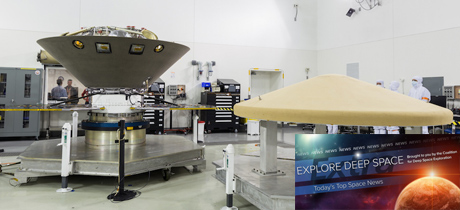In Today’s Deep Space Extra… NASA’s lunar focus, as outlined by President Trump’s Space Policy Directive 1, offers capabilities for the future exploration of Mars and other deep space destinations. At Vandenberg Air Force Base, California, NASA’s Mars InSight lander undergoes clean room preps for a May launch.
Human Space Exploration
The Space Review (4/9): The Trump Administration has directed NASA to focus on a human return to the moon, spelling out the direction in the December Space Policy Directive 1. However, within NASA, Mars still has a place in the agency’s future, noted NASA Acting Administrator Robert Lightfoot at a March Return to the Moon symposium in Washington. The administration’s first budget, the 2019 spending plan now before Congress, will enable the agency to plot a long term course starting with activities in cislunar space, including the assembly of a small human tended lunar orbiting habitat, the Lunar Orbiter Platform-Gateway (LOPG). In May, NASA plans to launch Mars Insight, a lander equipped to reveal the workings of the Martian interior.
Space Science
Inside the cleanroom where NASA’s new Mars lander waits to launch
Wired (4/9): At Vandenberg Air Force Base, California, NASA’s Mars InSight lander awaits launch as soon as May 5. Last week, news media were invited for a viewing that included an opportunity to experience the rigors of planetary protection — the mandatory measures taken to restrict contamination of the spacecraft from terrestrial microbes. InSight, launched on a United Launch Alliance (ULA) Atlas 5, is to land on the Red Planet in late November. There, it will lower surface and subsurface probes to explore the planet’s internal processes.
NASA is counting on long-lived Mars orbiter lasting another decade
Spaceflightnow.com (4/9): NASA’s high resolution camera equipped Mars Reconnaissance Orbiter (MRO), which is also equipped to relay data from NASA spacecraft on the Martian surface to Earth, was launched in 2005. With no successor on tap, NASA is counting on MRO to function through 2027, Leslie Tamppari, the orbiter’s deputy project scientist, informed a recent gather of the Mars Exploration Program Analysis Group. Originally envisioned as a five year mission, MRO is dealing with aging batteries and gyroscopes.
NASA studying sensor issue with Parker Solar Probe
Space News (4/9) NASA’s Parker Solar Probe reached its Kennedy Space Center launch site last week. Liftoff of the first mission to pass close to the sun is planned for a window running from July 31 to August 19. However, experts are still assessing issues with thermal control system sensors. Two dozen close flybys of the sun are planned between 2018 and 2025 to learn more the genesis of the solar wind and the thermal environment of the sun’s corona.
Other News
Space hotel already booked first four months
Houston Chronicle (4/9): Houston and Silicon Valley based Orion Span says the commercial space station project the company announced last week, Aurora Station, has already booked four months of hotel reservations. Aurora is to host six fliers at any one time, including two crew members beginning in 2022.
SpaceShipTwo is a step closer to space
The Space Review (4/9): Virgin Galactic’s SpaceShipTwo carried out an encouraging piloted flight test on April 5, its first to include rocket propulsion since a late 2014 test flight tragedy that claimed the life of one of two test pilots. However, it’s unclear how rapidly Virgin can move forward with passenger flights. Company executives are sounding a note of caution in how they will proceed with future testing.
Surprise launch sees China loft three Yaogan-31 reconnaissance satellites from Jiuquan
GB Times of Finland (4/10): The launch of a Chinese Long March 4C from the Gobi Desert early Tuesday lofted three reconnaissance satellites into orbit, according to the report. The launching marked the 11th of 2018 for Beijing.
Launching rockets from balloons is about to be a thing, but we need a better name than “Rockoons”
Universe Today (4/9): Leo Aerospace LLC, with ties to Purdue University, is exploring the use of balloons to launch rockets with small satellites on suborbital and orbital missions. The strategy is intended to offer sponsors of small satellite missions an alternative to sharing a ride with the large primary payloads assigned to conventional rockets. “Our goal is to give people access to space.” says Abishek Murali, Head of Mission Engineering at Leo Aerospace.

